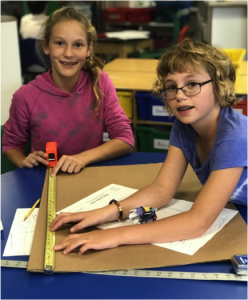Dynamic Math Learning at The Phoenix School
Written By: Barbara McFall, Head of School

Fall is the time of year when my students begin pestering me for “real” word problems. They love solving problems that include the names of their classmates and using a collaborative experience in which they can bounce ideas off one another as they work through more complex problems. My go-to resource for problems that create mathematical thinkers of my students is Exemplars.
At The Phoenix School, for many years (first in paper form, now digital) Exemplars has been a vital component of our math program. No more memorization and regurgitation that flies in – and out! — of kids’ brains. Exemplars work solidifies concepts, which are the foundation of mathematical learning, and allows for multiple solutions as well as encouraging creative thinking. It has the flexibility that enables us to extend concepts on which we have been working … and it is so well organized that it is easy to determine which sets of problems we need to best showcase particular math concepts.
Working Exemplars problems requires students to do much more thinking than in traditional mathematical learning formats. It teaches them to analyze information and focus on what is most important in getting to the solution. Exemplars problems also encourage students to use previous knowledge to work through solutions. When students discover how mathematical systems work, they can solve almost anything.
I choose a variety of math problems at all levels to begin. Varying math topics and levels help students learn to be flexible in their thinking and to transfer learning from one topic to another with ease. To create excitement, I change the names of the people in the problems to the names of students in my class. This leads to wonderful interactions which, in turn, leads to sharing ideas and helping one another. Each student gets a folder of problems. I put them on label paper so they can stick them in their math journals, one problem at a time. I don’t specify in which order students should work the problems – leaving it open-ended makes the math more engaging, encouraging students to ask questions of each other.
Some students like to work alone, while others prefer to connect with partners to work on problems they have in common. Using Exemplars legitimizes working with partners. It teaches students to share strategies, talk to others, and collaborate. Traditionally, teachers have considered the sharing of math work to be “cheating,” but I have found the learning to be so much better for all when my students share solutions. Math at The Phoenix School often becomes a social event as we collaborate on a particularly complex challenge, especially when we turn to using materials to represent a solution. Everyone’s ideas are considered and sometimes debated with passion!
I discuss different approaches to solving problems with students and expect them to document their work using charts/graphs/tables, words, numbers, equations, pictures/diagrams, and personal reflection. This helps students see math in multiple ways, which increases the learning. Requiring visual representations helps students organize their thinking so that, as I say to them, “Your paper talks to me. I can tell exactly what you were thinking as you worked through the problem.” For my older students, I always use the more challenging form of each problem. It is easy to extend these problems into algebra since so many lend themselves to finding the pattern and taking it to the algebraic equation.
From our youngest students to our oldest, we find that Exemplars problems engage, challenge, and create mathematical thinkers at every level. Our math program is truly strengthened by the Exemplars component.

